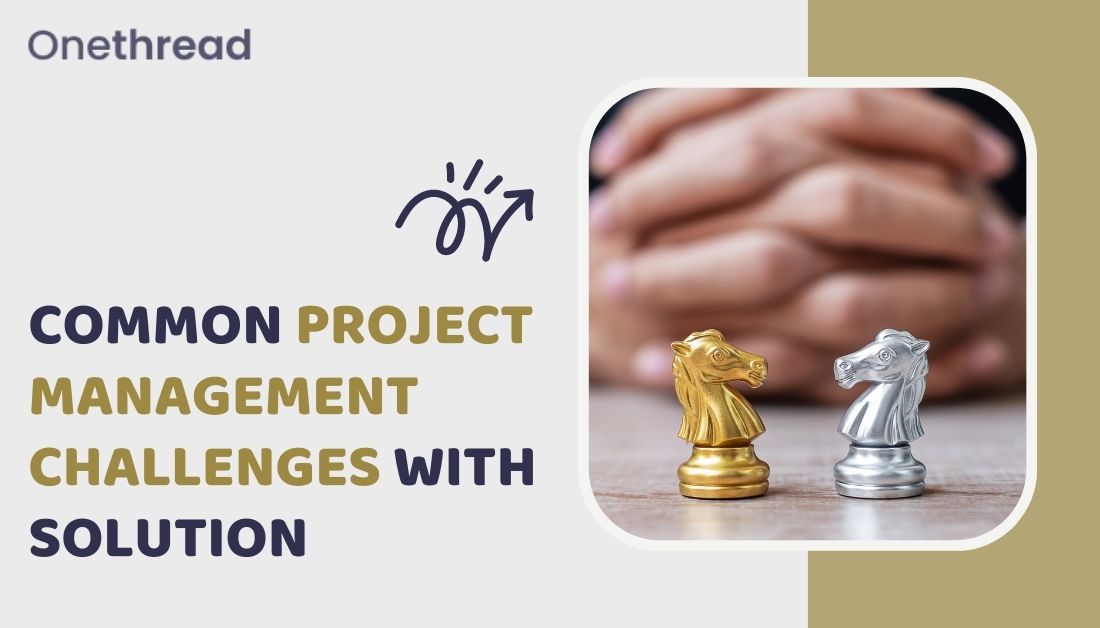Project management involves coordinating resources, tasks, and stakeholders to achieve specific goals within a defined timeframe. However, project managers often need help hindering progress and impacting project outcomes. By understanding and effectively addressing these project management challenges, project managers can enhance project performance and increase the likelihood of success.
Proactively addressing common project management challenges enhances project performance, mitigates risks, and increases the likelihood of success. Clear goals, efficient resource allocation, and strong communication and stakeholder engagement are crucial for overcoming these challenges. Project managers can navigate obstacles and achieve successful project outcomes by effectively managing these aspects.
Here are 15 typical project management challenges:
1. Unclear project goals and objectives:

More than clear project goals and objectives can create significant challenges in project management. When goals and objectives are clearly defined and communicated, it becomes easier for the project team to understand the purpose and desired outcomes of the project. Without clear goals, the team may lack direction, leading to confusion, misalignment, and inefficiency.
With clearly defined goals, it becomes easier to measure progress and success. However, project managers and team members may have different interpretations of project completion or achievement, leading to consistency in evaluating project milestones and outcomes.
More than clear goals also hinder effective decision-making. When the project team lacks a clear understanding of the project’s purpose and objectives, it becomes difficult to prioritize tasks, allocate resources appropriately, and make informed choices regarding project directions.
Solution
- Engage stakeholders: Involve key stakeholders in the goal-setting process to gather input, clarify expectations, and ensure a shared understanding of the project’s purpose and outcomes.
- Conduct thorough requirements analysis: Perform a comprehensive analysis to identify and define clear goals, understanding the project scope and measurable targets for success.
- Use SMART framework: Set goals that are Specific, Measurable, Achievable, Relevant, and Time-bound to provide a structured and actionable approach.
- Document goals: Create a project charter or similar document to document and share the agreed-upon goals and objectives.
2. Inadequate resource allocation and management:

Inadequate resource allocation and management is a common challenge in project management. It refers to situations where projects lack the necessary resources, such as personnel, equipment, or finances, allocated appropriately to support their successful execution. More help can result in delays, compromised deliverable quality, and increased project risks.
Effective resource allocation involves accurately assessing resource requirements for each project phase and ensuring that the right resources are available at the right time. This requires identifying any constraints or limitations that may impact resource availability or utilization. In addition, project managers must carefully balance competing resource demands across multiple projects or tasks within a project to optimize resource utilization.
Solution
To address inadequate resource allocation and management in project management, consider the following essential solutions:
- Thoroughly assess resource requirements for each project phase to identify gaps and allocate resources effectively.
- Prioritize tasks based on project needs and optimize resource utilization accordingly.
- Foster collaboration and communication between teams to share resources and prevent duplication.
- Develop a system for forecasting future resource needs based on historical data and expected changes.
- Remain flexible and adaptable to accommodate changes and unexpected events.
3. Poor communication among team members and stakeholders :

Communication is a shared project management challenge that can lead to misunderstandings, delays, and decreased productivity. When communication channels are effective, information is misinterpreted, instructions are clear, and project updates may need to be adequately shared. This disconnect hampers alignment and jeopardizes project success. Addressing this challenge requires proactive measures to foster effective communication and ensure smooth information flow among all project stakeholders.
Solution
To address the challenge of poor communication among team members and stakeholders in project management, several solutions can be implemented:
- Establish clear communication channels: Define and establish formal communication channels that ensure information flows smoothly and consistently among team members and stakeholders. This can include regular team meetings, status updates, and designated communication platforms.
- Foster open and transparent communication: Encourage a culture of open communication where team members feel comfortable expressing their thoughts, concerns, and ideas. Emphasize the importance of clear and concise communication to avoid misunderstandings and promote effective collaboration.
- Improve active listening: Encourage active listening among team members and stakeholders, ensuring everyone can be heard. Listening to others perspectives and feedback can foster better understanding and promote effective communication.
- Use visual aids and documentation: Utilize visual aids, such as charts, diagrams, and project documentation, to enhance clarity and understanding. Visual representations can help convey complex information and facilitate effective communication.
4. Scope Creep:

Scope creep occurs when project requirements expand beyond the initial scope, leading to delays, increased costs, and resource challenges. It arises from evolving expectations, unclear boundaries, and inadequate change control. Therefore, project managers must monitor and control the scope to prevent unnecessary deviations and maintain project alignment.
Solution
To address scope creep, project managers should implement effective scope management strategies. This involves:
- Clearly defining and documenting project scope: Establish a comprehensive and well-defined scope statement that outlines project objectives, deliverables, and boundaries. This provides a baseline for scope control and helps manage stakeholders’ expectations.
- Change control processes: Implement a structured change control process that requires formal evaluation and approval of any proposed changes to the project scope. This ensures that all scope modifications are appropriately assessed for their impact on timelines, resources, and overall project goals.
- Robust project monitoring and tracking: Continuously monitor project progress and compare it against the defined scope. Use project management tools and techniques to track tasks, milestones, and deliverables, identifying deviations early on.
- Proactive risk management: Anticipate potential scope changes and associated risks. Develop contingency plans to address unexpected alterations and have mitigation strategies in place to manage the impact of scope creep.
5. Unattainable project timelines and deadlines

Unrealistic project timelines and deadlines pose a challenge in project management. Setting impractical timeframes can increase pressure on the team, compromise quality, and lead to rushed decision-making. Establishing realistic timelines requires careful evaluation of project requirements, dependencies, and available resources.
Solution
- Conduct a comprehensive assessment of project requirements, dependencies, and available resources.
- Collaborate with stakeholders to establish realistic and achievable timelines.
- Prioritize tasks effectively and allocate resources accordingly.
- Implement a robust project planning process to ensure all aspects are considered.
- Regularly monitor progress and make adjustments as needed.
- Communicate openly with stakeholders about any potential timeline challenges.
- Seek input from the project team to validate the feasibility of proposed timelines.
- Consider historical data and lessons learned from similar projects.
- Identify and address any external factors that may impact timelines.
6. Insufficient project planning and risk management:

Insufficient project planning and risk management can create significant challenges in project management. For example, when project planning is inadequate, there is a higher chance of encountering unforeseen obstacles, delays, and cost overruns. On the other hand, with a well-defined plan, it becomes easier to establish clear project objectives, allocate resources effectively, and establish a realistic timeline.
Similarly, considering risk management can lead to unexpected issues and setbacks during project execution. Failure to identify and address potential risks can result in delays, increased costs, and compromised project outcomes. Adequate risk management involves identifying potential hazards, assessing their potential impact, developing strategies to minimize risk, etc.
Solution
- Embrace Agile methodologies:
Adopt agile project management methodologies such as Scrum or Kanban to promote flexibility, adaptability, and continuous planning throughout the project lifecycle. These approaches emphasize iterative planning, regular team collaboration, and the ability to adjust project priorities based on evolving requirements.
- Utilize project management software:
Leverage project management software tools with features like task tracking, resource allocation, and risk management modules. These tools can streamline planning processes, improve communication, and provide real-time visibility into project progress and potential risks.
OneThread:

If you are looking for an efficient project management tool, OneThread can be a true lifesaver.
It is a versatile collaboration and project management tool that facilitates seamless organizational communication and teamwork. It provides threaded discussions, task management, integration with external tools, and advanced search capabilities in one user-friendly interface. With features like tagging, task assignment, and document sharing, OneThread helps teams stay organized, prioritize work, and achieve their goals efficiently. In addition, it ensures secure and private communication, making it a valuable tool for enhancing productivity and streamlining collaboration.
Features
The features of this tool can significantly improve project management.
- Threaded discussions: Create and participate in organized conversations around specific topics or projects.
- @mention notifications: Tag team members to engage them in discussions and ensure their active involvement.
- Task management: Create tasks within threads, set due dates, and track progress to transform discussions into actionable items.
- Integration with external tools: Seamlessly connect with popular productivity tools, such as project management platforms, document-sharing services, and calendars.
- File sharing: Attach relevant files and documents to threads, facilitating easy access and collaboration.
- Unified workspace: Provide a centralized platform for teams to collaborate, eliminating the need to switch between multiple applications.
- Robust search functionality: Quickly locate specific information, conversations, or files using keywords, tags, and filters.
- Intuitive user interface: User-friendly design that is accessible to both technical and non-technical team members.
- Responsive across devices: Maintain seamless connectivity and engagement across various devices.
- Conduct a comprehensive project risk workshop:
Facilitate a dedicated workshop with key project stakeholders to brainstorm and identify potential risks. Encourage open discussions and collaboration to ensure a more comprehensive risk identification process.
- Foster a proactive risk management culture:
Encourage project team members to actively identify and communicate potential risks throughout the project. For example, implement a risk register where team members can document and track risks, promoting a proactive approach to risk management.
- Engage subject matter experts (SMEs):
Collaborate with SMEs early in the project planning phase to gain their insights and expertise. Involving experts from relevant domains can help identify potential risks specific to the project and establish more effective risk mitigation strategies.
7. Lack of stakeholder engagement :

A challenge in project management is when stakeholders need to be more actively engaged and involved in the project. This lack of participation can lead to misalignment, communication gaps, and a lack of support for the project. It may occur due to inadequate stakeholder identification or ineffective communication strategies. Overcoming this challenge is crucial to ensure stakeholders’ perspectives are considered and their concerns are addressed throughout the project.
Solution
Addressing the need for more stakeholder engagement and involvement in a project requires implementing effective strategies to actively engage stakeholders throughout the project lifecycle. Some potential solutions include:
- Stakeholder analysis: Identify all relevant stakeholders and understand their interests, needs, and potential impact on the project.
- Clear communication: Establish open and transparent communication channels to keep stakeholders informed and engaged. Use a variety of communication methods to accommodate different stakeholder preferences.
- Regular meetings and updates: Schedule regular meetings and provide project updates to ensure stakeholders are involved, aware of project progress, and have opportunities to provide feedback.
- Stakeholder participation: Involve stakeholders in key project activities, such as requirement gathering, decision-making, and testing, to ensure their input is considered and incorporated.
- Stakeholder management plan: Develop a stakeholder management plan that outlines how stakeholders will be engaged, their roles and responsibilities, and strategies for addressing potential conflicts or challenges.
- Continuous relationship building: Foster positive relationships with stakeholders by understanding their needs, addressing their concerns, and demonstrating the value of their involvement in the project.
8. Conflicting priorities and unclear roles and responsibilities:

Conflicting priorities and unclear roles and responsibilities among project team members can lead to clarity, efficiency, and delays. This challenge arises from a need for more transparency in project objectives, poor communication, or organizational changes. Resolving this challenge requires effective coordination and establishing a shared understanding of priorities and roles within the team.
Solution
Solution for conflicting priorities and unclear roles:
- Establish clear communication channels within the project team.
- Define and communicate project objectives to ensure everyone is aligned.
- Assign roles and responsibilities clearly to each team member.
- Conduct regular team meetings to discuss priorities and address any conflicts.
- Foster open and transparent communication among team members
- Regularly review and adjust roles as needed based on project progress.
- Provide ongoing support and clarification to team members regarding their roles.
- Ensure clear channels for reporting and addressing conflicts or issues.
- Promote a culture of teamwork and collaboration to minimize conflicting priorities.
9. Ineffective project tracking and monitoring:

Ineffective project tracking and monitoring hinder the ability to assess project progress, identify issues, and make informed decisions. This lack of visibility can lead to missed deadlines, budget overruns, and overall project inefficiencies. Establishing robust tracking and monitoring mechanisms is essential for the timely identification of deviations and proactive management.
Solution
Possible solutions for addressing the challenge of ineffective project tracking and monitoring include:
- Implementing project management software for real-time tracking and reporting.
- Establishing clear project milestones and performance metrics.
- Regularly reviewing progress against established targets.
- Conducting frequent status meetings to assess project status.
- Utilizing project dashboards or visualizations to enhance visibility.
- Ensuring team members are aware of their responsibilities and have access to necessary resources.
- Implementing a robust project communication plan to keep stakeholders informed.
- Encouraging proactive communication and issue escalation within the project team.
- Regularly monitoring and analyzing project data to identify trends and areas for improvement.
- Providing appropriate training and support to team members on project tracking tools and techniques.
- Conducting periodic project audits to assess the effectiveness of tracking and monitoring processes.
- Seeking feedback from stakeholders on the effectiveness of project tracking and adjusting approaches as needed.
- Encouraging a culture of accountability and ownership among team members for tracking their tasks.
- Ensuring that project documentation is up to date and easily accessible for reference.
- Regularly evaluate and refine project tracking and monitoring processes based on lessons learned from previous projects.
Resistance to change and stakeholder buy-in :

Resistance to change and lack of stakeholder buy-in pose challenges in project management. People may resist changes due to fear, job security concerns, or skepticism about the benefits. This resistance can hinder progress and create friction within the project team. Similarly, when stakeholders lack enthusiasm or support, it can undermine project success and hinder effective collaboration. Overcoming these challenges is crucial for successful project implementation.
Solution
- Effective Communication: Communicate the need for change clearly and consistently, emphasizing the benefits and addressing concerns. Engage stakeholders in open and transparent communication to foster understanding and build trust.
- Stakeholder Engagement: Involve key stakeholders early in the project, seeking their input, and addressing their needs. Encourage active participation, listen to their perspectives, and incorporate their feedback into the project plans and decision-making processes.
- Change Management Strategies: Implement change management strategies that focus on managing resistance, addressing individual concerns, and providing support and training. This includes conducting change impact assessments, training programs, and facilitating open dialogue to address concerns.
- Leadership and Sponsorship: Strong project leadership and sponsorship are vital in gaining stakeholder buy-in. Engage influential stakeholders and project sponsors to champion the project and help overcome resistance by addressing concerns and advocating for the project’s benefits.
11. Inadequate project documentation and knowledge transfer :

Inadequate project documentation and knowledge transfer pose challenges. More documentation is needed to ensure an understanding of project requirements, leading to errors and delays. In addition, knowledge sharing among team members limits collaboration and the utilization of valuable insights from previous projects. Addressing this challenge requires improved documentation practices and effective knowledge sharing.
Solution
To address the challenge of inadequate project documentation and knowledge transfer, the following solutions can be implemented:
- Establish clear documentation standards: Define guidelines for documenting project requirements, processes, decisions, and relevant information. This ensures consistency and clarity in the project documentation.
- Document throughout the project lifecycle: Encourage team members to regularly document their activities, progress, and outcomes. This helps capture important information in real-time and avoids relying on memory or delayed documentation.
- Implement a centralized knowledge management system: Create a centralized repository or platform where project documentation, lessons learned, and other knowledge resources can be stored and easily accessed by team members. This promotes knowledge sharing and continuity across projects.
- Conduct knowledge transfer sessions: When transitioning team members or starting new project phases, organize dedicated knowledge transfer sessions to ensure critical information and insights are shared. This can include mentoring, shadowing, or documentation review.
12. Team conflicts and lack of collaboration:

Team conflicts and a lack of collaboration can hinder project progress. Differences in personalities and work styles can lead to disagreements, while a lack of collaboration can cause miscommunication and delays in decision-making. Therefore, resolving conflicts and fostering cooperation is essential for successful project completion.
Solution
- Clarify roles and responsibilities: Clearly define each team member’s roles, responsibilities, and expectations to minimize ambiguity and potential conflicts arising from overlapping or unclear responsibilities.
- Encourage teamwork and collaboration: Implement collaborative tools and techniques, such as regular team meetings, brainstorming sessions, and cross-functional collaboration, to foster a sense of unity and shared ownership among team members.
- Mediate conflicts: If conflicts arise, address them promptly and impartially. Encourage active listening, promote understanding, and seek resolutions that benefit the team.
- Training and development opportunities: Offer training programs or workshops on conflict resolution, effective communication, and teamwork to enhance the team’s skills and promote a harmonious work environment.
- Lead by example: Project managers should exemplify the desired behavior by demonstrating open communication, active listening, and respectful collaboration. Setting a positive example can inspire team members to follow suit.
13. Budget constraints and financial limitations

Budget constraints and financial limitations refer to the challenges project managers face when working within a limited budget or restricted financial resources. These constraints require project managers to carefully prioritize expenses and make strategic decisions to optimize resource allocation and deliver the project successfully while staying within the allocated budget.
Solution
- Efficient resource allocation to optimize utilization.
- Accurate cost estimation and ongoing tracking of project expenses.
- Prioritization and trade-offs to align with the available budget.
- Negotiating with vendors and suppliers for favorable pricing and terms.
- Implementing risk management strategies to minimize financial impacts.
- Continuous monitoring and control of project finances.
- Transparent communication with stakeholders about budget limitations.
14. Technological and infrastructure limitations :

Technological and infrastructure limitations are systems, tools, equipment, or physical infrastructure constraints hindering project progress. Examples include outdated software, insufficient network capabilities, or inadequate facilities. Overcoming these limitations may require alternative solutions or adapting the project plan to work within the existing constraints.
Solution
Here are five quick solutions for addressing technological and infrastructure limitations in a project:
- Assess limitations: Evaluate the extent and impact of technological and infrastructure constraints.
- Explore alternatives: Seek out alternative resources or technologies to overcome the limitations.
- Engage experts: Collaborate with subject matter experts or consultants for specialized insights.
- Adjust plans: Adapt project plans and timelines to work within the available resources.
15. External factors
External factors, such as regulation changes, shifts in market conditions, or natural disasters, can significantly influence project management. These factors are beyond the project team’s control and can challenge project execution. Adapting to regulatory changes, navigating volatile market conditions, and mitigating the impact of natural disasters require careful consideration and contingency planning to ensure successful project outcomes.
Solution
- Stay informed and proactive. Keep track of regulatory changes, market conditions, and potential natural disasters.
- Build flexibility and adaptability into project plans to accommodate changes.
- Conduct thorough risk assessments and develop mitigation strategies.
- Consider appropriate insurance coverage and review contracts for provisions related to external factors.
- Continually monitor the external landscape and evaluate the impact on the project, making necessary adjustments.
Conclusion :
In conclusion, project management presents challenges requiring proactive management and mitigation. Clear goals, effective resource allocation, and open communication are crucial for overcoming these challenges and achieving project success. By anticipating and addressing these obstacles, project managers can navigate complexities, mitigate risks, and deliver successful outcomes.
